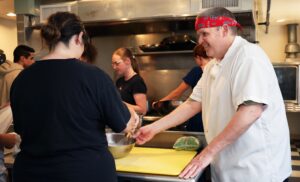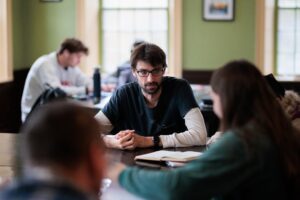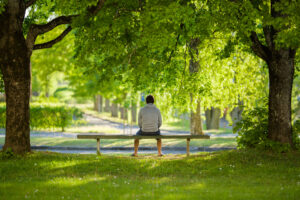In the 1990s, when I was the young president of an international college with campuses in Tokyo and Osaka, Japan was a country under pressure. There was profound political division, a looming recession, and a surge in crime and terrorism – including the Sarin subway attack of 1995. Despair was so ubiquitous that I was late to work about once a week due to suicide by train – and that was just on my subway line. This social and economic uncertainty increased the perceived necessity to attend a prestigious university, driving admissions standards and tuition costs to unattainable heights. For college-oriented families, failure to gain admission to a preferred college meant, simply, failure, and even academically talented young people were folding under the pressure.
Hikikomori
By almost all measures, the world seemed pretty scary to many Japanese youth in the ’90s, and the resulting fear elicited a number of different reactions.
My high achieving students at Keio and Tokyo University, where I was an adjunct professor, doubled down on their pursuit of safe, traditional corporate jobs. To gain admission into these elite schools, they had forgone high school sports, extracurriculars, and leisure time in favor of grueling and expensive “cram schools,” where they prepped for college admissions exams after school and on weekends until well into the night, often seven days a week.
The quirky kids at the small, funky college I ran – a “kokusai daigaku” with transfer agreements to S.U.N.Y and other American and European universities – came to class wearing pajamas, neon hair, gyrary makeup, and other clear but harmless symbols of their rejection of, and rejection by, mainstream Japanese culture. They enrolled at the daigaku to escape Japan. While I enjoyed my high achieving Keio and Todai students, I loved my funky gakusei – an eclectic crew of smart, sweet, anxious, “square pegs” who refused to give up on themselves just because their society did. They would be okay, I knew, because they were still trying, still fighting. They were still fighting, I suspected, because someone close to them – a parent, grandparent, teacher, aunt-believed in them and would not let them give up.
Another group of Japanese youth also wore their pajamas all day, but as an act of retreat, not rebellion. These young people were termed Hikikomori, by famed psychiatrist Tamaki Saito. The Hikikomoris’ response to a scary world was to avoid it completely. These young people opted out of society by the hundreds of thousands, simply refusing to leave their bedrooms.
The American School-Refusal Epidemic
Now, twenty years later, the U.S. is experiencing similar pressures and a phenomenon not unlike Hikikomori. Like 1990’s Japan, the U.S. is experiencing intense political division, a looming recession, an increase in crime and terrorism, a spike in despair and suicide, and extreme college admissions pressure. Add to all this a pandemic, and we now have our own pajama crisis.
Our version of Hikikomori, aka school refusal, is an epidemic of anxiety-based withdrawal from a scary world. Prior to the COVID pandemic, the National Institutes of Health estimated that as many as 5%, or 2.5 million young people refused school and were, as a result, homebound. According to research conducted jointly by Stanford University and the Associated Press, another 230,000 students never returned to school after the pandemic, and that’s just in the 21 states that provided data.
Japan’s Hikikomori crisis of the 90s and America’s school refusal crisis of today share another common feature – cultural accommodation. Rather than aggressively addressing Hikikomori as the public-health crisis that it was, many in Japan chose to view the massive withdrawal of youth from society as just a modern manifestation of the ancient Japanese ancestral desire for solitude. In other words, they found a way to explain away Hikikomori as a cultural phenomenon. As such, Hikikomori has been rationalized and normalized and, as a result, has gone largely unchallenged.
Similarly, America’s school refusal epidemic coincides with a cultural movement toward safety, protection, and accommodation. These safety responses are not limited to objectively dangerous phenomena, but to any perceived threat, whether physical, emotional, or social. Hyper-protective safety behaviors* are increasingly promoted as culturally evolved safeguards against previously underestimated threats.
Our media and social media provide constant, inescapable reminders of the dangers of daily life, magnifying these dangers to the point that sticks and stones may break my bones, and words, differences of opinion, and microaggressions can also really harm me. Our response to these often-exaggerated threats is to accommodate retreat through safe spaces, school withdrawal, social avoidance, and staying home. Compounding these social forces is the fact that our terrified youth now have the perfect camouflage for their retreat, as homebound behaviors have become suddenly and profoundly normalized post pandemic. The pandemic also provided massive accommodations for retreat through the proliferation of home-based services like video conferencing, distance learning, food delivery, telehealth, and remote therapy.
The 2030 Problem
The problem with extreme accommodation is that it perpetuates and magnifies our fear of objectively harmless phenomena. Uncontested, avoidance responses are self-reinforcing, isolating our youth and decreasing engagement, self-efficacy, and resiliency. Since Japan has a twenty-year jump on this problem, Hikikomori provides us with a window into how this problem might evolve in the US.
Now, two decades after its emergence, Hikikomori has become what the Japanese are calling the “2030 Problem.” Because Hikikomori has gone largely unchallenged, many of the pajama-clad legion from my days in Japan are still homebound. Their parents, many now approaching their eighties, won’t be around much longer to take care of them. What then? To many Japanese, the situation seems hopeless.
The Hope
Assuming, however, as I do, that Japanese Hikikomori and American school refusal are just anxiety-disorders on an epidemic level, the situation for both countries is actually far from hopeless. Clinical research and practice make it clear that anxiety and related disorders are highly treatable; in fact, anxiety is among the most treatment-responsive of all mental-health problems. With clinically significant anxiety, as with most mental-health challenges, it is critical for loved ones and mental health practitioners to begin their intervention by meeting the sufferer where she is. But it’s equally critical not to stay there. In the case of bedroom-bound hikikomori and school refusers, we meet them where they are so that we can leave together.
It is this “leaving together” that is the most important but challenging aspect of effective anxiety interventions, especially in a culture that values comfort and perceived safety above all else. In fact, the most research – supported treatment modality – exposure and response prevention therapy, or ERP – is downright counterculture. ERP is predicated on the simple but profound notion that the only way to overcome disabling fears is to face them, which is easy to say but hard to do. This approach requires enormous courage; courage that we, as caregivers, must first cultivate in ourselves so that our children and our clients can borrow it from us until they are able, through a combination of challenge and support, to develop it in themselves.
The only way to avoid our own “2050 Problem” is to actively challenge the cultural trend toward accommodation and withdrawal. In the fight or flight equation that so often defines anxiety, this constitutes a commitment to fight. We must fight the “two lies of anxiety,” as described by Dr. Ellen Hendriksen in a recent New York Times article: first, that our children’s fears are actual threats; second, that our children are too weak to face those fears. Rebutting those lies requires that we believe in our children’s innate strength, resiliency, and self-efficacy in ways that have become, tragically, counterculture.
I saw this fight twenty years ago in my pajama’d gakusei. I see it today in our Mountain Valley residents and their brave parents. Most of these bright, sensitive people would not describe themselves as fighters or as brave, counter-culture rebels. But that’s exactly what they are. And it will save them.


